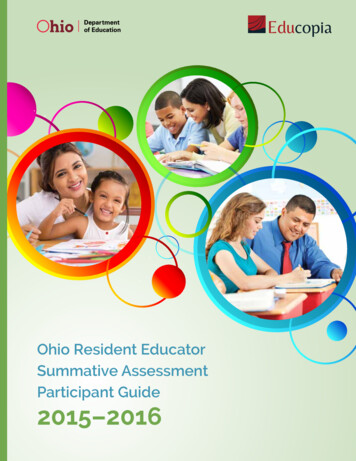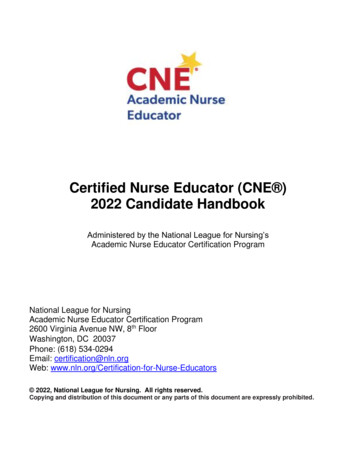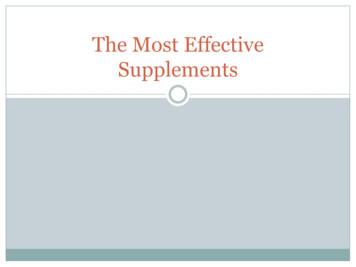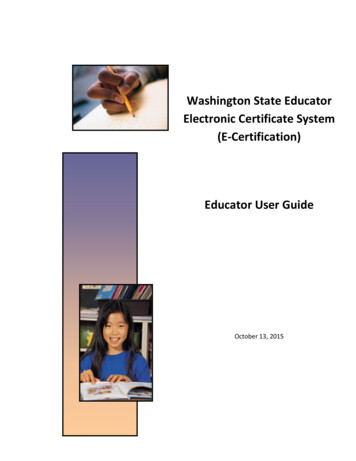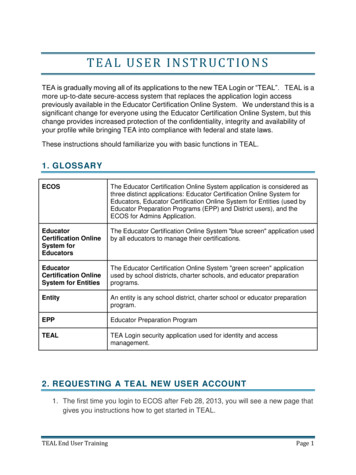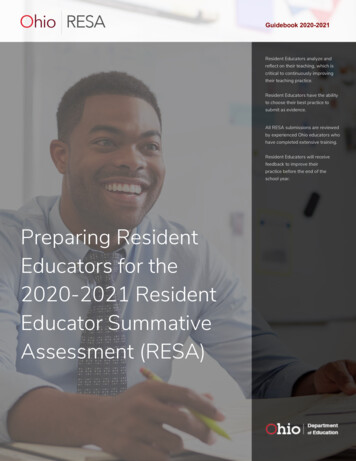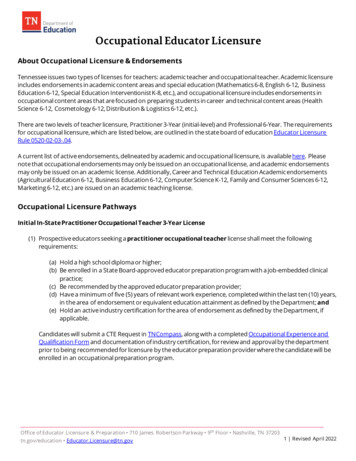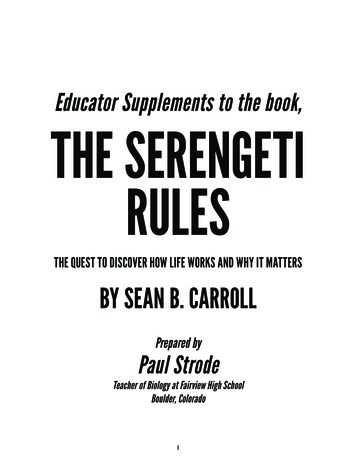
Transcription
Educator Supplements to the book,THE SERENGETIRULESTHE QUEST TO DISCOVER HOW LIFE WORKS AND WHY IT MATTERSBY SEAN B. CARROLLPrepared byPaul StrodeTeacher of Biology at Fairview High SchoolBoulder, Colorado1
TABLE OF CONTENTSI. SUMMARY OF THE SERENGETI RULES 4–8II. INTRODUCTION TO QUESTION SETS FOR THE SERENGETI RULES 9–11III. ENGAGEMENT QUESTIONS 12–21IV. DISCUSSION QUESTIONS 22–30V. ASSESSMENT QUESTIONS 31–40VI. COURSE CURRICULUM ALIGNMENTS: AP BIOLOGY, IB BIOLOGY, NGSS 41–53VII. EXAMPLE ADVANCED BIOLOGY CURRICULUM MAP FOR THE SERENGETI RULES 54–572
HOW TEACHERS MIGHT USE THE SERENGETI RULES IN THE CLASSROOMThe Serengeti Rules, molecular biologist Sean Carroll takes the reader on a journey through the history of the scientificdiscovery of many of nature’s most important regulatory mechanisms, from molecules to megafauna. In the spirit ofTheodisius Dobzhansky, Carroll teaches us in The Serengeti Rules that nothing in biology makes sense except in the lightof regulation. Thus, at the very center of the book is the big, biological idea of homeostasis. Indeed, a key to understanding how living systems work and the supporting roles played by evolutionary processes is understanding how a relatively stable environment, be it in a cell or in an ecosystem, is maintained and regulated. Throughout the book, Carrolltells the stories of the scientists—and their discoveries—that have given us our current understanding of regulation innature. But in the stories, Carroll also teaches the reader about the nature of science and scientific reasoning, the importance of modeling, and how scientific discovery is full of determination and success but also frequented with failure.Through stories of real scientific discovery, The Serengeti Rules provides a historical foundation and context for ourcurrent understanding of our most fundamental biological topics. Soon after its publication in March of 2016, socialmedia, like the National Association of Biology Teachers Facebook page and the College Board AP Biology onlineDiscussion Board, began buzzing with excitement about the book. Many teachers immediately realized the value ofassigning the book as summer reading for students enrolled in their AP and IB Biology courses. Other teachers mightconsider using the book to drive or supplement the curriculum topics in their biology courses or to pique studentcuriosity in many of the course topics. However, no materials were available to help teachers integrate the book, itsstories, and its overarching theme of regulation (homeostasis) into their current curriculum frameworks. It is thusthe goal of Princeton University Press to provide those critical materials and curriculum connections to teachers andtheir students. The materials available can be used directly in the classroom to supplement what teachers already useto reinforce the big ideas, learning targets, and science practices that frame the biology content. The support materialswe have developed are designed to enhance students’ biology knowledge and also their scientific skills. Below is a briefsummary of The Serengeti Rules and descriptions of the materials available and how a teacher might use them in theclassroom.3
I. SUMMARY OF THE SERENGETI RULESPart I: Everything Is Regulated. One focus in Part I is the work of Walter Cannon, a Harvard University physiologist. Inhis early years as a scientist, Cannon questioned why fear and stress affect an animal’s physiology. Cannon hypothesizedthat an animal’s normal physiological states “remain steady because factors exist that resist change in either direction,positive or negative,” but that stress disrupts many highly regulated mechanisms in animals. Cannon’s most importanttest of this hypothesis came while he was assisting in a field hospital in Europe during World War I. Cannon noticedpatterns in the wounded soldiers that often led to death, including blood pressures that dropped to levels as low as 50when blood bicarbonate ion concentration and blood pH also dropped. With regulation in mind, Cannon reasonedthat adding bicarbonate ion to the soldiers’ blood could raise blood pH and also blood pressure. The method workedand allowed wounded soldiers to be, in the words of Cannon, “snatched from death.” After the war, Cannon continuedwith his physiology and regulation research and eventually described the steady states that the body maintains withina narrow window, like blood pressure and blood pH, with a new term: homeostasis.In Part I we are also introduced to another scientist, Charles Elton. In the 1920s, Elton worked on ecosystem regulatory processes, which are at the other end of the spectrum of biological organization as those studied by Cannon.Elton was a master of abductive reasoning: borrowing ideas from other research and applying them to the systems hewas studying. For example, it was Elton, who, from years of field work in hostile arctic ecosystems, abducted the idea ofscarce resources from economics and described how the availability of food regulates the sizes of animal populations.Indeed, it is Elton who published the first diagram of a complex food web.Part II: The Logic of Life. An essential component of the scientific processes that generate new knowledge is modeling.In modeling, we make claims (hypotheses) about the real world and then build theoretical models to test those claims.If a theoretical model is valid, it should fit with what we know about the real world. Thus, when we test our models,the predictions we make should generate data that are evidence that our models work. A well-known example of modelbuilding is the original Watson and Crick model for the structure of DNA.In Part II, Sean Carroll introduces us to some models for regulation that illustrate and simplify the complex interactions from cells to ecosystems that we seek to understand. For example, A indirectly regulates C by regulating B, or thebuildup of A inhibits its own synthesis (see Figure 1). We learn that it was through the work of scientists like JacquesFigure 1. The general rules of regulation and the logic of life. Figure is from The Serengeti Rules, p. 68.4
Monod and FranÇois Jacob that we first discovered these negative feedback mechanisms in the context of enzymefunction. Among many other great stories in this section, Carroll also recounts how the discovery by Janet Rowley ofchromosomal translocations eventually led to the invention of the successful cancer drug Gleevec. Several, if not all,of these significant discoveries may be new to many teachers. The stories can function to put a human face on coursecontent that may be difficult or abstract. The stories can also provide an important historical context to some of ourmost important scientific discoveries of the past century.Part III: The Serengeti Rules. “The regulation of populations must be known before we can understand nature andpredict its behavior.” This quote introduces Part III and comes from a now-classic paper published in 1960 by three ecologists, Nelson Hairston, Fred Smith, and Lawrence Slobodkin. The paper is titled “Community Structure, PopulationControl, and Competition” but is known by scientists in the field of ecology simply as “Hairston et al., 1960.” In thepaper, Hairston and his colleagues proposed that “herbivores are held down in numbers by predation below the levelat which they damage the vegetation.” This statement, along with the other observations presented in the paper, becameknown as the original Green World Hypothesis. The Green World Hypothesis explains in part why plant-eating animals are not generally and consistently able to grow their populations to sizes that eventually consume all the Earth’splants: the population sizes of herbivores are regulated by the predators who eat them. This idea frames the stories inPart III, where Carroll describes regulation at its largest scales.The first story Carroll tells is that of Robert Paine. Paine’s story is an example of what science textbooks are unable to do because of space constraints and curriculum requirements. Fortunately, a book like The Serengeti Rulescan bring the material alive for students. In The Serengeti Rules, we learn that Paine was a student of Fred Smith’s,and in large part through Smith’s influence, Paine became well known in the 1960s, 1970s, and 1980s for his kickit-and-see experimental methods (Paine’s early work has now been brought to life in a short film titled Some Animals Are More Equal than Others: Keystone Species and Trophic Cascades. The film and its supporting resources are available through the Howard Hughes Medical Institute’s Biointeractive website: ascades).Early in his career, Paine initiated several large and years-long experiments to test an idea of his called the TrophicCascade Hypothesis. In the 1960s Paine experimented with predator removal along the Pacific Northwest coast. WhenPaine removed all individuals of the starfish species Pisaster ochraceus from their habitat, two species of marine herbivores, goose barnacles and mussels, exploded in number. Paine showed from this experiment that the herbivores in thishabitat were indeed being “held down in numbers by predation below the level at which they damage the vegetation.”After removal of the starfish, the barnacles and mussels also crowded out many other herbivore species and had almostcompletely devoured four species of algae, a major component of the “vegetation” of this coastal marine ecosystem. In1969, after he was convinced of the direction of his results, Paine wrote a letter to the editor of The American Naturalistjournal, describing his observations and introducing the field of ecology to a new way of thinking about species interactions: the Keystone Species concept. In his letter, Paine explained, “These individual populations [of starfish] are thekeystone of the community’s structure, and the integrity of the community and its unaltered persistence through time,that is, stability, are determined by their activities and abundances.” Paine had cleverly abducted the idea of the keystonefrom its function in stone arches. Figure 2 shows that the stone at the top of the arch, the keystone, keeps the entire archfrom falling into itself; and so it goes with keystone species.Figure 2. The keystone in a stone arch keeps theentire arch from falling into itself.5
Table 1. From Robert Paine’s 11-year Mukkaw Bay starfish removal study, published in 1974.6
Robert Paine continued to remove starfish from his experimental plots for several years. By 1973 Paine had monitored his starfish removal experiment for 11 years, and he was ready to publish more than a letter to the editor of ajournal. Table 1 comes from Paine’s Mukkaw Bay data that he published in the journal Oecologia in 1974.The data in Table 1 show that at the start of Paine’s experiment, mussels (Mytilus californianus), one of the starfish’smain food resources, covered between 1% and 5% of the rock face habitat, and shared the habitat with 17 other species.However, just three years later, on the rock faces without starfish (“removal” in the table), only two species from the rockface community were left and the mussels covered 95% of the rock surface area. By the end of the study in 1973, 100% ofthe area on the rocks in the removal group were covered with mussels, whereas on the control rock faces (“control” inthe table), the total number of species had increased to 20. Thus, removing Pisaster starfish allowed mussels to quicklydominate the rock faces, which in turn drove down the species richness (number of species) of the entire ecosystem.Various illustrations of this keystone species affect revealed by Paine have made their way into the textbooks used inmany biology classrooms. Teachers may recognize Figure 3 from Biology by Campbell and Reece, or may have a similarfigure in their textbooks. Figure 3 summarizes the species richness data described in Table 1. However, the textbooksdo not convey the fascinating stories behind discoveries like these. In The Serengeti Rules, Sean Carroll makes it clearthat stories, especially the ecological ones, are salient, if indeed one of our main goals in teaching is to leave lasting impressions on our students so that they can achieve a deep understanding and respect for how the natural world works.Figure 3. Data from Robert Paine’s starfish removal experiment as illustrated in the textbookBiology: N. A. Campbell, J. B. Reece, L. A. Urry, M. L. Cain, S. A. Wasserman, P. V. Minorsky, and R. B. Jackson(2008). Biology, 8th edition. San Francisco: Pearson Benjamin Cummings. Data are from a 1974 paper by Paine.In the second half of Part III, Carroll ultimately takes us to the real Serengeti in Africa and explains how these basicrules of regulation, which govern how cells function, also influence the community interactions we observe in vastecosystems. We are introduced to the interactions among various charismatic species, many of which are already wellknown to our students, like elephants and lions, but also some not so well-known species, like gazelles and wildebeest.Here Carroll brings in the ideas of competition for resources, body size, population density, and migration as key variables in how the Serengeti system itself is regulated.Carroll doesn’t stop with the Serengeti. The last few chapters of The Serengeti Rules are a whirlwind tour of ecosystem processes back and forth between Africa and the United States. We travel from Lake Erie of Ohio to the plains ofGhana to lakes in Wisconsin to Yellowstone National Park and finally back to Africa to Gorongosa National Park inMozambique. In Gorongosa we learn how a devastating civil war produced an ecosystem that was depleted of mostof its large animals. The silver lining to this cloud of human conflict is that ecologists can monitor the results of anunplanned kick-it-and-see experiment on an extremely large scale. Researchers can see in real time how the rules ofregulation appear and take hold as the Gorongosa ecosystem surges back to life. The results will likely be as predictableas they are unexpected.7
Back in the Introduction, Carroll writes, “Diseases are mostly abnormalities of regulation, where too little or toomuch of something is made.” From molecules to megafauna, regardless of the scale, The Serengeti Rules teaches thereader that to understand the disease state of a system, even an ecosystem, one must intimately understand how thatsystem is regulated.As mentioned above, a teacher may simply assign the book as summer reading to prepare students for a bulk of thecontent they will be covering in an upper level course like AP Biology, IB Biology, AP Environmental Science, or IB Environmental Systems and Society. Sean Carroll’s writing style is engaging enough to keep most any student’s attention.And in many places, Carroll avoids delving too deeply into the scientific details. For example, when Carroll begins toexplain the regulation of cholesterol synthesis, he is clear in his intention to keep it as simple as possible:“[B]ut it was known that the rate of cholesterol synthesis was determined by the activity of the enzyme that acted atthe first step of the pathway, whose name is a mouthful: 3-hydroxy-methylglutaryl coenzyme A reductase. I’ll just callit ‘the reductase,’ as it is the one and only enzyme I am going to talk about in this chapter, and what it does exactlyis not essential to know here.”As a challenge to students, teachers can encourage them to look for topics in the curriculum that are relevant to thescientific stories in the book—they are everywhere!8
II. INTRODUCTION TO QUESTION SETS FOR THE SERENGETI RULESNearly 100 questions have been written to engage students in the content and concepts presented in The Serengeti Rules,as well as to inspire reflection and discussion. Possible assessment questions have also been written to accompany eachchapter. Teachers can use the questions directly or can use parts of a question or even rewrite questions to fit studentknowledge and ability level. To aid teachers in choosing appropriate questions for their students, each question hasbeen labeled with question level (standard level or higher level) and question type (modeling question, data-basedquestion, or nature of science question). For convenience of curriculum coverage, each question has also been alignedwith specific concepts and topics in both the AP Biology curriculum and the IB Biology curriculum.Engagement QuestionsIf the book is not assigned as summer reading (some schools may not allow summer reading assignments), teachers canassign chapters or sections of chapters as the school year progresses.However, before students begin each reading assignment, they can be given engagement questions that get themthinking about what they may already know about a topic or that reveal a misconception they may have. Here is anexample from Chapter 6, Some Animals Are More Equal than Others, where students are assigned to read the first sevenpages of the chapter: There seems to be an abundance of plants in many locations on the Earth, especially in those locations whereclimate supports and promotes plant growth. In other words, the Earth is very green. Propose a hypothesis thattentatively answers this question: With so much plant food available, why don’t we see an equally abundantnumber of animals eating them? Describe a method you could design to test your hypothesis.Discussion QuestionsRegardless of the approach teachers use to incorporate student reading of The Serengeti Rules, discussion questions arean effective way for students to process and review the stories and the science. Here are two examples of discussionquestions that follow Chapter 6, Some Animals Are More Equal than Others: Robert Paine used a kick-it-and-see approach to understand and reveal the role Pisaster starfish play in their tidalzone ecosystem. Paine was able to show that the starfish function as the keystone species in their habitat. Compare Paine’s approach to the approach used by Jim Estes and John Palmisano to investigate the role sea ottersplay in their ecosystem. From observations they made in a freshwater stream in Oklahoma, ecologist Mary Power and her colleagueshypothesized that bass acted as a keystone species. Sketch and label a diagram that illustrates the method usedby Power and her team to test their hypothesis.Assessment QuestionsNo matter how teachers choose to use The Serengeti Rules to supplement their curricula, we have provided one or twoassessment questions that relate to or extend from the concepts presented in each chapter. Thus the assessment questions are not intended to simply check student recall of the content of each chapter; instead they challenge studentsto pool their knowledge and science literacy skills to make claims and arrive at conclusions. Indeed, many of thesequestions simulate the kinds of thought-provoking, data-based questions students might encounter on their AP and IBend-of-program exams. Here is an example of an assessment question for Chapter 8, Another Kind of Cancer:1. Study the four graphs in Figure 4. The data in the graphs come from an experimental forest in North Carolina.Part of the forest was exposed to CO2 levels meant to simulate the atmosphere predicted for the year 2050: 580 partsper million (ppm). Another part of the forest was left alone to experience the ambient CO2 levels of 1996, when experiments on the forest began: 380 ppm. Researchers sampled four different types of arthropods in the two parts of theforest to get an idea of what effect higher CO2 levels might have on forest ecosystem food webs. Wasps and spiders arecarnivores and prey on caterpillars and mites, which are herbivores. Before the study was conducted, researchers had9
Figure 4. Population sizes of four different groups of arthropods sampled in habitats under two different atmospheric conditions: ambient (1996) CO2 levels (380 ppm; dashed line with triangles) and future (2050) CO2 levels (580 ppm; solid line withcircles). The data in the graphs are from J. Hamilton, A. R. Zangerl, M. R. Berenbaum, J. P. Sparks, L. Elich, A. Eisenstein, and E. H.DeLucia (2012). “Elevated Atmospheric CO2 Alters the Arthropod Community in a Forest Understory.” Acta Oecologica, 43, 80–85.already discovered that plants grow faster in elevated CO2 conditions, but this faster growth makes the plants’ leaves lessnutritious. The less nutritious leaves require herbivores to eat more plant material and spend more time eating plantsto get the same nutrition as they do from plants that grow more slowly under lower CO2 conditions.a. Identify what you see in each of the graphs.b. Based on the graphs, interpret what effect you think higher CO2 levels have on forest ecosystem food webs.c. Propose a hypothesis to explain the effect you described in part (b).Course Curriculum AlignmentsTeachers at the secondary level like to see how a new resource aligns with the curriculum they are following. The threemain curriculum frameworks to which teachers look for alignment are the AP Biology Course Description, the IBBiology Guide, and the Next Generation Science Standards (NGSS). For example, the AP Biology Course Descriptionincludes four Big Ideas. The following is an alignment example:CHAPTER 3: GENERAL RULES OF REGULATIONHistorical context: Jacques Monod and François Jacob discover feedback mechanisms in bacteria metabolism and reveal several general rules of regulation.From the AP Biology Course Description:1. Big Idea #2: Biological systems utilize free energy and molecular building blocks to grow, to reproduce, and tomaintain dynamic homeostasis.10
2. Enduring Understanding 2.C: Organisms use feedback mechanisms to regulate growth and reproduction, andto maintain dynamic homeostasis.3. Essential knowledge 2.C.1: Organisms use feedback mechanisms to maintain their internal environments andrespond to external environmental changes.4. Learning Objective LO 2.18: The student can make predictions about how organisms use negative feedbackmechanisms to maintain their internal environments.Example Course OutlineAt the end of this document there is also an example curriculum map for a first-year Advanced Biology course withideas for how The Serengeti Rules might fit into the course content.NOTE ABOUT SYMBOLSAt the end of each question are two sets of symbols. One set identifies the questiontype. The other set identifies general connections to the Advanced Placement (theScience Practices and Enduring Understandings) and International BaccalaureateBiology curricula. Use the following key as a guide for question type:SLHLDBQMQNOSStandard level (General HS Biology) QuestionHigher level (AP, IB, Intro College) QuestionData Based QuestionsModeling QuestionsNature of Science Questions11
III. ENGAGEMENT QUESTIONSIntroduction: Miracles and Wonder1. The growth rate of the cells that make up a human embryo right after conception is exponential: one cell becomes two cells, which become four cells, then eight cells, 16 cells, and so on. This rate of cell population growth beginsto slow down after about 20 days, but from 50 days to birth the mass of a human fetus continues to increase from about1 gram to 3.5 kg as even more cells are added. By the time we reach adulthood, we have about 30 trillion cells, and wemore or less stay that way for the rest of our lives. What ideas do you have for how all of this growth is regulated? Whatprocesses are responsible for the rapid growth of the number of cells followed by a slowdown and ultimate balancingact at a relatively unchanging number of cells? (SL) (AP: SP 2, 2.B–E; IB: 1.6)2. Figure 5 shows the actual growth curves of two populations. Both curves have time on the x-axis. Which curvedo you think is for the global human population in billions of people from 1800 to the present, and which curve is fora microbe called Lactobacillus plantarum on a log scale grown at 35 C? Explain the reasoning you used to make yourclaim. (HL, DBQ, NOS) (AP: SP 1–2, 2.A,C,D; IB: C.5)ABFigure 5. Two growth curves of real populations. Sources: M. H. Zwietering, I. Jongenburger, F. M. Rombouts, and K. Van’t Riet(1990). “Modeling of the Bacterial Growth Curve.” Applied and Environmental Microbiology, 56(6), 1875–1881, and Wikipedia(https://en.wikipedia.org/wiki/File:Human population growth from 1800 to 2000.png).3. Determine whether the following statement is true or false and explain your reasoning for your choice: Diseasesare mostly abnormalities of regulation, where too little or too much of something is made. (SL) (AP: 2.A–2.E; IB:6.1–6.6, 11.1, 11.3, D.1–D.6)Part I: Everything Is RegulatedCHAPTER 1: THE WISDOM OF THE BODY1. Think of a time when you were preparing to perform in some way in front of an audience (give a speech, play asolo in a concert, run a race, etc.). In small groups, discuss with your classmates how your body reacts (i.e., how did youphysically feel) as the moment of a performance approaches. Come up with a list of those reactions, and propose someideas to explain these physiological reactions. (SL) (AP: D.2; IB: 6.1, 6.4, A.3, D.2, D.4)2. The body can largely take of itself. So what is the function doctors? (SL) (AP: 2.A–2.E; IB: 6.1–6.6, 11.1, 11.3, D.1–D.6)3. When your body gets cold, you shiver. When your body gets hot, you sweat. Why do you think your body resiststhese changes in temperature? What other changes are resisted by your body? (SL) (AP: 2.C, 4.A; IB: 2.5, A.3)12
CHAPTER 2: THE ECONOMY OF NATURE1. List and describe as many factors in nature that can keep populations from growing out of control. (SL) (AP: 2.C;IB: C.5)Part II: The Logic of LifeCHAPTER 3: GENERAL RULES OF REGULATION1. Enzyme A regulates (promotes and suppresses) the function of enzyme B, and enzyme B regulates the function ofEnzyme C. What is the relationship between enzyme A and enzyme C? (SL) (AP: 2.C; IB: 2.5)2. Study Figure 6. (SL, MQ) (AP: SP 1, 2.C; IB: 4.1, 8.1, 11.3, A.3, C.5)a. Use arrows and descriptions to explain how the firing of the rubber band is regulated (suppressed and alsopromoted) by the firing mechanism.b. The way that the firing mechanism in Figure 6 works is by using a system called double-negative feedback.Identify a system in nature that you think might also be regulated by a double-negative feedback mechanismand is analogous to the rubber band firing mechanism. What part of the system plays the part of the pulleyin the middle? The rubber band? The trigger arm?Figure 6. A possible simple firing mechanism for a rubber band.3. Chapter 3 recounts how two biologists, Jacques Monod and François Jacob, discovered the general rules of enzymeregulation in a microbe called E. coli. In 1961, long after their discoveries, Monod and Jacob famously claimed that it wasa “well- known axiom that anything found to be true of E. coli must be true of Elephants.” What do you think is trueabout nature’s regulatory mechanisms that allowed Monod and Jacob to make this claim? (HL) (AP: SP 7, 1.B; IB: C.5)13
CHAPTER 4: FAT, FEEDBACK, AND A MIRACLE FUNGUS1. Consider the following claim: The cholesterol molecule is vital for life. Is this claim true or false? Explain why youthink so. (HL) (AP: 2.B, 4.A; IB: 1.3, 2.3, 6.2, D.1, D.3)2. In the middle of the past century, physiologist Ancel Keys discovered that firemen in Naples, Italy, who lived ondiets high in fresh produce had low blood cholesterol and few heart attacks. He also found low blood cholesterol andfew heart attack rates in poor people in Spain who had diets low in expensive foods like meats. Keys compared thesefindings to the high blood cholesterol of American businessmen and concluded that wealthier people had diets richin fats, which was causing them to have more heart attacks than other groups. Keys medical colleagues were skeptical.(HL, NOS) (AP: 2.B, 4.A; IB: 1.3, 2.3, 6.2, D.1, D.3, D.4)a. Using your knowledge of how science works, comment on why you think that Ancel Keys’s colleagues wereskeptical of his claim.b. If you were Ancel Keys, what kind of a study would you conduct to answer the skeptical questions fromyour colleagues?3. What does it mean for a person to be homozygous for a trait? Heterozygous? Is one better than the other? Explainyour answer. (SL) (AP: 3.A, 3.B; IB: 3.1, 3.3, 3.4, 10.1)4. Figure 7 shows the biosynthetic pathway of cholesterol. If you were to try to regulate this series of reactions, evenshut them down completely, where do you think would be a good place to intervene? Why? (SL) (AP: SP 1, 2.C; IB: 2.1,2.3, 2.5)Figure 7. A simplified version of the cholesterol biosynthesis pathway—the process actually requires more than 30 enzymes. Thefirst two structures that begin the pathway are shown for reference, as is the structure of the final product, cholesterol. The arrowsrepresent the enzymes that catalyze each reaction as well as the order of the structures as they are synthesized.14
CHAPTER 5: STUCK ACCELERATORS AND BROKEN BRAKES1. Karyograms are photos of the chromosomes found in the nucleus of an organism’s cells. A karyogram shows bothsets of chromosomes an individual received from its two parents as they appear during Prophase of the cell cycle. Studythe human chromosome karyograms in Figure 8. (SL) (AP: 3.A; IB: 3.2)a. Which karyograms show a biologically female karyotype? Which show a biologically male karyotype? Howdo you know?b. Which karyograms show chromosomal abnormalities? How do you know there is an abnormality?c. Extension: Do some additional research to identify each chromosomal abnormality and describe itssymptoms.Figure 8. Four different human chromosome karyograms.2. Which factors from the list below are possible causes of cancer? (SL) (AP: 2.E, 3.C; IB: 1.6, 3.4, 6.4)I. VirusesII. RadiationIII. Chromosomal abnormalitiesa.b.c.d.IV. Genetic
2 table of contents i. summary of the serengeti rules 4–8 ii. introduction to question sets for the serengeti rules 9–11 iii. engagement questions 12–21 iv.


